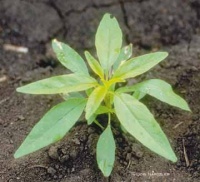Attacking Waterhemp Resistance

Sometimes the best defense is a good offense. When fighting herbicide-resistant weeds, offensive moves could mean robust crop and herbicide mode of action rotations. Crop farmers on the Northern Plains may want to keep that advice in mind as glyphosate-resistant waterhemp begins to move into the region.
“Glyphosate-resistant waterhemp is certainly in southern Minnesota and is a growing problem in that area,” says Jeff Stachler, Ph.D., Extension weed scientist at North Dakota State University and University of Minnesota. “Corn and soybeans are the main crops in southern Minnesota, which is why there is so much resistance. It is also present in the southern Red River Valley, and we expect it to become a problem in southeastern North Dakota as well.”
Growers on the Plains are accustomed to managing other resistant weed species, such as ALS-resistant kochia and Russian thistle. Resistant waterhemp, however, may be a much greater challenge. “It already is a huge issue for soybean and corn growers,” Stachler says. “Waterhemp produces large quantities of seed, and there are limited herbicide options.”
In fact, waterhemp was among the first weeds documented to be resistant to multiple modes of action – ALS-, HPPD-, PSII- and PPO-inhibitors and glyphosate.
“A fifth example of resistance in one weed species is overwhelming evidence that resistance to virtually any herbicide used extensively on this species is possible,” says Aaron Hager, Ph.D., Extension weed specialist at the University of Illinois. “Waterhemp is not a weed species that can be adequately managed with one or two different herbicides. This troublesome weed requires a much more integrated approach.”
Crop rotation patterns in and near the southern Red River Valley exacerbate the problem. Many growers plant Roundup Ready corn, soybeans and sugarbeets in succession, with no break in the glyphosate cycle. Continuous exposure to a single mode of action places significant selection pressure on waterhemp and other weeds, increasing the likelihood of selecting glyphosate-resistant weeds.
“There may not be much resistant waterhemp here yet,” says Kevin Thorsness, technical service representative for Bayer CropScience in North Dakota. “But as we continue to plant more and more Roundup Ready corn, soybeans and sugarbeets in southeastern North Dakota, it’s only a matter of time before we see development of waterhemp resistance to glyphosate.”
Wheat and other small grains have always been good rotation crops, for multiple agronomic reasons. They also can be helpful in breaking up the glyphosate cycle and helping prevent waterhemp resistance. Controlling weeds in wheat with Huskie herbicide from Bayer CropScience will reduce waterhemp pressure when growers rotate to other crops the following season.
With two modes of action, Huskie herbicide from Bayer CropScience gives cereal growers effective, broad-spectrum weed control without relying on glyphosate. One mode of action inhibits an enzyme critical for plant pigmentation, resulting in the bleaching and rapid control of weeds. A second mode of action blocks photosynthetic processes. As a result, Huskie controls more than 50 hard-to-manage broadleaf species, including many that have become resistant to ALS inhibitors and provides partial control of 20 others.
Thorsness recommends having a good resistance-management program in place to avoid waterhemp resistance. “Don’t rely on a single technology, and possibly add LibertyLink soybeans to the rotation,” he says. Rotate herbicide modes of action, not just crops. Remember, the best way to combat resistance is to play good offense.”






